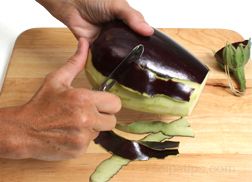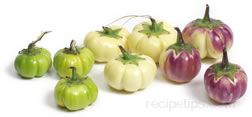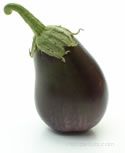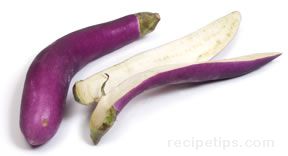The American varieties are most often dark purple in color, larger in size, and pear-shaped, such as the Santana or Rosa Bianca. The White Eggplant, which can be egg or pear-shaped with a white outer skin that may be thick and tough in texture, is grown in the U.S. as well as many Asian countries. The inner flesh is firm, close grained and more delicate in flavor. Other types such as the Apple Greens and Louisiana Long Greens are long and slender, very similar in texture to other U.S. varieties with thin skins that cover thick inner flesh. Many of the varieties grown in other countries are commonly grown in the U.S.
The Asian Eggplants (Chinese, Japanese, Thai), which are typically sweeter in flavor, vary more in shape and color than the American Eggplants. The Asian varieties are generally long and slender or round and ball shaped. Chinese and Japanese Eggplants range in size from 3 to 10 inches. The Chinese varieties are generally white to lavender in color, while the Japanese are light purple to a dark purplish black. Common varieties include the Lilac Bride, the Udmalbet, both providing a generally sweet flavor. The ball-shaped Thai Eggplants range in size from a half inch to several inches in diameter, with an outer skin that may be colored white, yellow, green, or lavender. Common varieties are the white and green Thai Kermit, the White Round, or the dark purple Bambino. The skin is very firm and the inner meat or flesh is generally somewhat bitter with a slight fruity flavor, containing seeds that should be removed before eating. Some of the small round varieties are also referred to as Bitter Balls or Garden Eggs. The Thai Eggplant is often used for making curry dishes, soups, stews, egg dishes, or pickled to be served as a snack or side dish. The African Eggplant is similar to the Thai in size and shape. Small in size, the Eggplant may be smooth and round or evenly shaped with indented and rounded sections, similar to miniature pumpkins. This variety of Eggplant generally contains a firm textured meat with a bitter flavor that is often added to soups and stews, complimenting the flavors of other ingredients. Common varieties are the Aubergine du Burkina-Faso, (pale yellow, pumpkin shaped) and the Comprido (bright orange, oval shaped). The African Eggplant may also be known as Garden Eggs, Mock Tomato, ngogwe, or nyanya chungu. Italian E, referred to as melanzane are similar in shape to the American varieties, but are often smaller and thinner in size. In addition, they also have a somewhat sweeter more delicate flavor. The main varieties include the pear-shaped, dark purplish-black Eggplant commonly referred to as the Italian Eggplant, which is very similar to the American Eggplant. The Bianca Oval (a white oval shaped fruit) and the heirloom Rosa Bianca are also Italian Eggplants. The Bianca Eggplants have a thin flesh covering a mildly sweet-flavored, creamy-textured meat.
An eggplant requires a long, warm growing season, so it is most plentiful in late summer to fall. Almost all varieties of Eggplant contain over 80% water with a flesh that provides a minor amount of nutrients such as calcium, iron, vitamin B, and vitamin C. When selecting this fruit, choose those that have a shiny tight and firm skin, making sure they are not dull colored or showing any rust spots. They should be heavier in weight and not feel light for the size of the Eggplant. To prepare, Eggplant is excellent when stuffed with a variety of ingredients. And it can be sautéed, broiled, baked, grilled, or slowly cooked as an ingredient in meat, rice, or cheese dishes and stews. Eggplant can also be substituted for pasta in lasagna dishes. For storage, it is often suggested to keep Eggplant in a cool area that may be close to room temperature of the kitchen, but not the refrigerator. The skin of the Eggplant blemishes easily when exposed to the cool temperatures of a refrigerator. Since some Eggplants may be bitter tasting, it has been a common practice to add salt to the cut pieces of the vegetable to help draw the bitter flavor out of the meat and to enhance the flavor. Salting also assists to keep the Eggplant from absorbing large amounts of oil as it cooks. To salt Eggplant, cut the Eggplant into round slices or lenghtwise into strips that are cut into cubed pieces and place the pieces into a colander. Then sprinkle coarse salt over all the pieces (approximately 1 tablespoon per 2 pounds of Eggplant) and it may help to place a heavy plate over the contents to keep them pressed closely together. Allow the pieces to remain in the colander for 30 to 60 minutes, then rinse away the salt and gently pat dry the pieces with paper towels.
An Eggplant may also be referred to as aubergine (French), berenjena, brinjal, Guinea squash, garden egg (bitter ball), melongene, melanzane, or zapallito (Spanish).















